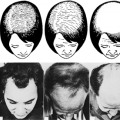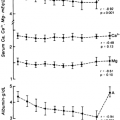THYROGLOBULIN AND THYROGLOBULIN ANTIBODIES
Part of “CHAPTER 33 – THYROID FUNCTION TESTS“
Serum thyroglobulin (Tg) measurements are useful in the follow-up of patients with thyroid cancer28,29 (see Chap. 40). Numerous studies have shown that very low or undetectable Tg levels are found in patients who have been successfully treated and have no evidence of residual thyroid tissue. The performance characteristics of the assay used are important. Five problems complicating current Tg assay methods have been evaluated for six different Tg assays.29 First, standardization has been lacking, although a Tg reference standard has now been adopted. Second, functional sensitivity in some assays is suboptimal: Small amounts of residual thyroid tissue may go undetected. Third, poor precision of repeated interassay measurements, over a relevant clinical time frame of 6 to 12 months, may limit the ability to detect cancer recurrences or progression. Fourth, the “hook” effect may lead to a report of falsely normal or low Tg values in sera with very high Tg concentrations, especially in an
immunoradiometric assay (IRMA). Samples should be run undiluted and at a 1:10 dilution to avoid this potentially serious mistake. Fifth, Tg antibodies can overestimate the Tg level in double-antibody RIAs, whereas IRMAs underestimate the true value. Sera should be screened for the presence of Tg antibodies, which should be reported to the clinician.29
immunoradiometric assay (IRMA). Samples should be run undiluted and at a 1:10 dilution to avoid this potentially serious mistake. Fifth, Tg antibodies can overestimate the Tg level in double-antibody RIAs, whereas IRMAs underestimate the true value. Sera should be screened for the presence of Tg antibodies, which should be reported to the clinician.29
Stay updated, free articles. Join our Telegram channel

Full access? Get Clinical Tree





